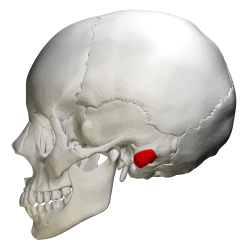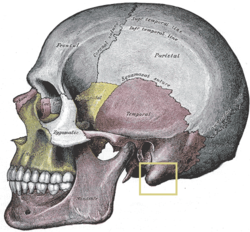Mastoid process
| Mastoid process | |
|---|---|
 Side view of skull. Mastoid process shown in red. | |
 Mastoid process | |
| Details | |
| Identifiers | |
| Latin | processus mastoideus ossis temporalis |
| Anatomical terms of bone | |
The mastoid process is a conical prominence projecting from the undersurface of the mastoid portion of the temporal bone. It is located just behind the external acoustic meatus, and lateral to the styloid process.
Structure
The mastoid process projects from the temporal bone in the skull and is roughly pyramidal or conical in shape. It is also filled with cavities called "air cells" known as sinuses. On the medial side of the mastoid process is a deep groove, the mastoid notch (also known as the digastric fossa), for the attachment of the digastric muscle.
Variation in humans
Its size and form vary somewhat; it is larger in the male than in the female.
Development
The mastoid process is absent or rudimentary in the neonatal skull. It forms postnatally, as the sternocleidomastoid muscle develops and pulls on the bone.
Function
One important role for this bone is as a point of attachment for several muscles - the splenius capitis, longissimus capitis, digastric posterior belly, and sternocleidomastoid. These muscles are one reason the mastoid process tends to be larger in men, because men have bigger muscles as a rule and thus require larger points of attachment.
History
Etymology
The term “mastoid” is derived from the Greek word for “breast,” a reference to the shape of this bone.
See also
Additional Images
-
Animation.
-
Animation. Left temporal bone.
-
Base of skull. Mastoid process labeled at middle left.
-
Close up of the right side of the skull. Mastoid process at left.
-
Mastoid process labeled at bottom.
-
Mastoid process labeled bottom right.
-
Left temporal bone. Muscle attachments are shown in red lines.
-
Base of skull. Muscle attachments are shown in red lines.
-
Side view of head, showing surface relations of bones. (Mastoid process labeled near center.)
References
![]() This article incorporates text in the public domain from the 20th edition of Gray's Anatomy (1918)
This article incorporates text in the public domain from the 20th edition of Gray's Anatomy (1918)
External links
- lesson5 at The Anatomy Lesson by Wesley Norman (Georgetown University)
- Diagram - #5 (source here)
- Template:RocheLexicon









